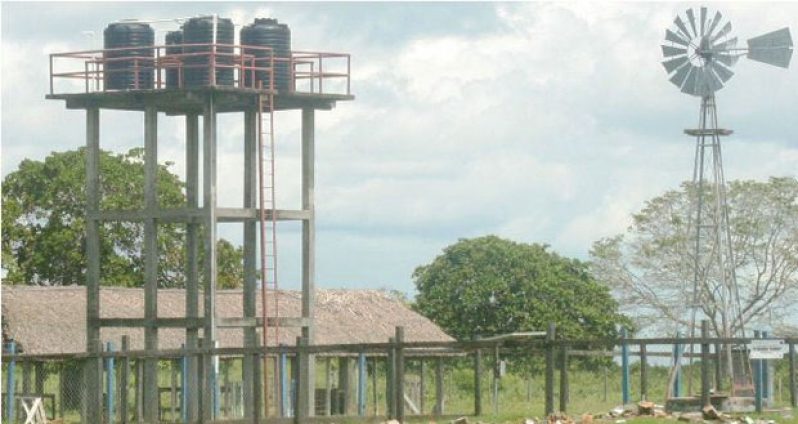SILVIE Henry, a 12-year-old hinterland resident, was elated when for the first time she realised that she didn’t have to find an excuse to tell her teacher why she was unable to do her homework!She always wished to become a teacher, but could not study at nights. There was no electricity. She was happy because she was being afforded the opportunity to study to achieve her dream. This can now become a reality as her family recently received solar panel, compliments of the Government.
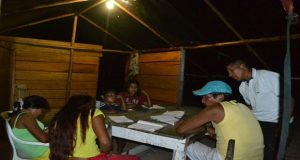
When the Government launched its Hinterland Electrification Programme, it was done with a vision to take reliable energy supply to remote parts of Guyana, more so to bridge the gap between ‘coastlanders’ and Guyana’s indigenous people.
Since its introduction in 2005, numerous Amerindian communities are now benefitting from solar powered energy to their homes, and already the beneficiaries are seeing tangible results. Scores of communities in Regions One, Seven, Eight, Nine, and Ten have benefited from this initiative.
During a recent visit to Monkey Mountain and Campbelltown, Region Eight, it was more than evident that the residents welcome the initiative. For decades, many of the beneficiaries knew nothing other than ‘flambo’, torchlight and in a few instances, mini generator sets, which carried a very high fuel cost, attached to it.
Now just over three months, residents of Monkey Mountain have been enjoying the benefits of solar energy.
In that community, 140 households have benefitted from this initiative, which has provided much needed relief.
Other residents said they are seeing improved grades from their school age children while the electricity is assisting in their own productivity.
INCREASE IN PRODUCTIVITY
This community depends heavily on farming and in some instances, gold mining. However, most of the women said having the solar panels has now increased productivity as they are now able to work late hours into the night to make cassava bread and spin cotton.
In the past, these trades were only conducted in the day, and now, being provided with the wherewithal to work at nights, most of the women said they are able to give more support to their male partners in the farmlands during the day. Further, this initiative at its initial stage, provided jobs for persons in the community.
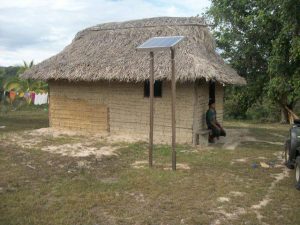
As has been the case in every other community where the project has been established, Community Support Officers (CSOs) and other youths were trained for the setting and maintenance of these solar panels. These persons also received a stipend for their work.
Moreover, the maintenance of these panels is of equal importance to the Office of the Hinterland Electrification Programme. It is for this reason each community was asked to set up a system whereby each beneficiary would pay a monthly fee of $500 to their Village Council. This money goes towards maintenance in the event a system develops problems. After a two-year period, this fee would increase by $100 and in instances where a unit is not functioning as it should; one of the persons trained is required to service that system.
Meanwhile, several miles away in a quiet community called Campbelltown, which is located a stone’s throw from Mahdia, 98 households are also benefitting from the solar panel project.
According to the Toshao of that community, Ms Marbell Thomas, the feedback thus far is overwhelming as many of the beneficiaries are now having electricity in their homes for the first time in decades.
Just four months of having the luxury of electricity to their homes, residents confess that it brings a whole new meaning to life and their day-to-day activities.
In the past, residents said at nightfall the only option was to turn into bed early, while now they can enjoy family time with children while assisting with school work.
Women get to put in a little extra work making their cassava bread, which is a main course meal for many households.
This initiative also allows the beneficiaries to enjoy a little more spending as the money they once spent on kerosene to light their ‘flambo’ now goes to other much needed items in and around the home.
TANGIBLE BENEFITS
Teachers of both the nursery and primary schools in the Monkey Mountain and Campbelltown areas have all reported that there has been a dramatic increase in the children’s performance in school.
This is owing to the fact that the students are able to put in extra studies at night under the light of energy saving bulbs. In the past, this was something unheard of in this community.
Homework was done either at day-light and in some instances never done and the most common excuse was always “we don’t have light”. Parents of school age children have also shared similar sentiments as they too are getting positive feedback from teachers about their children’s performance, much to their delight and satisfaction.
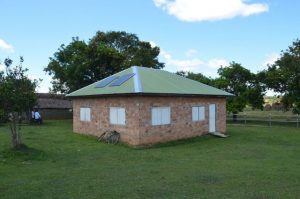
These are the sentiments of parents of many other communities in Regions Seven, Eight and Nine, all of whom have benefitted from this solar panel initiative.
In Region Nine, communities which have benefitted from this initiative include Shulinab, Meriwau, Potarinau, Shea, Parishara, Hiowa, Semonie, Katoka, Yupukari, Kaicumbay, Nappi, and Quatata.
In Region Eight, places including Kato, Kurukabaru, Waipa, Bamboo Creek, Micobie, Chiung Mouth, Karisparu, and Kamana, are just a few communities that have benefitted.
Each package distributed thus far included a Photo-Voltaic Panel, a 6A-12V DC charge controller, a 67 Ah -12V deep cycle gelled electrolyte battery fitted with suitable terminals, sunlight resistant cable, 10 A, 1-pole DC circuit breaker, 9W-12VDC compact fluorescent lamps and a DC lightning arrester, with a unit cost of US$241.
Larger panels have been fitted in primary schools and health centres.
Improving energy access is recognised as a key area for expanding access to affordable, clean energy which plays a crucial role in realising the Millennium Development Goals (MDGs) and achieving the objectives of sustainable development under Guyana’s Low Carbon Development Strategy.
As the project unfolded it also saw the provision of a mini-grid at Mahdia and Port Kaituma and the revamping of the grid work at Lethem.
Some of the pilot installations were of 339 solar PV systems of 125w in group three communities where the populations were less than 1,000 persons.
There was also the installation of 2 grid ties 5kw on the hospitals of Port Kaituma and Mahdia. Mini grids were installed in those communities.
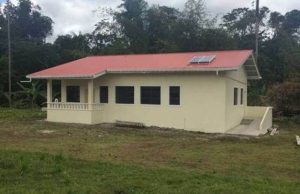
Additionally, in Orealla-Siparuta, Moraikobai and St. Cuthbert’s Mission, technical feasibility using small grids is being tested.
Other projects include the upgrade of the Lethem distribution network and the installation of 1390 PV 65w systems in 17 villages.
Only recently, Government announced that another 6000 solar panels would be distributed to families across the country. (GINA Feature)





.png)


